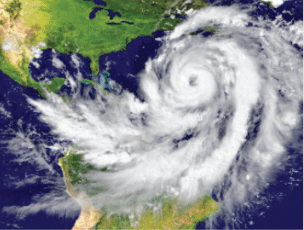A hurricane is a huge storm
1. .............
A hurricane is a huge storm! Each hurricane usually lasts for over a week, moving 10-20 miles per hour over the open ocean. Hurricanes gather heat and energy through contact with warm ocean waters. Evaporation from the seawater increases their power. Hurricanes rotate in a counter-clockwise direction around an “eye” in the Northern Hemisphere and in a clockwise direction in the Southern Hemisphere. The centre of the storm, or “eye” is the calmest part. It has only light winds and fair weather. When they come onto land, the heavy rain, strong winds and large waves can damage buildings, trees and cars.
2. .............
Hurricanes only form over really warm ocean water of about 27°C or warmer. The atmosphere (the air) must cool off very quickly the higher you go. Also, the wind must be blowing in the same direction and at the same speed to force air upward from the ocean surface.
3. .............
The Atlantic hurricane season is from June 1 to November 30, but most hurricanes occur during the fall months. The Eastern Pacific hurricane season is from May 15 to November 30.
4. .............
Nothing except geography. Tropical storms occur in several of the world’s oceans, and except for their names, they are essentially the same type of storm. In the Atlantic Ocean, Gulf of Mexico, and the Eastern Pacific Ocean, they are called hurricanes. In the Western Pacific Ocean, they are called typhoons. In the Indian Ocean, the Bay of Bengal, and Australia, these types of storms are called cyclones.
5. .............
Those brave people work for the National Oceanic and Atmospheric Administration (NOAA). Each mission lasts about ten hours. The crews pass four to six times through the storm. The planes carry radar, sophisticated computers, and weather instruments that help them learn more about the hurricanes. By mission’s end, NOAA can warn everyone in the hurricane’s path.

